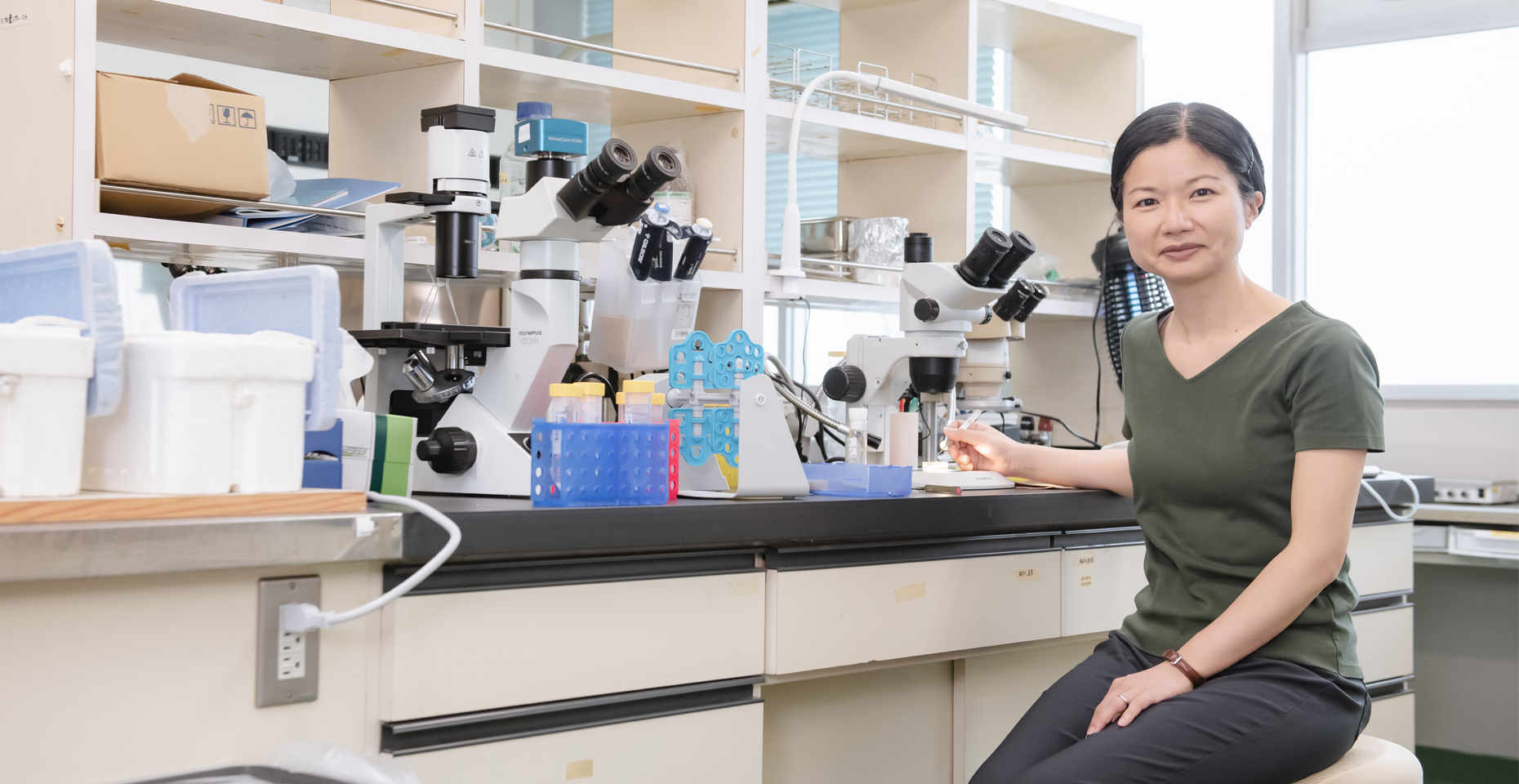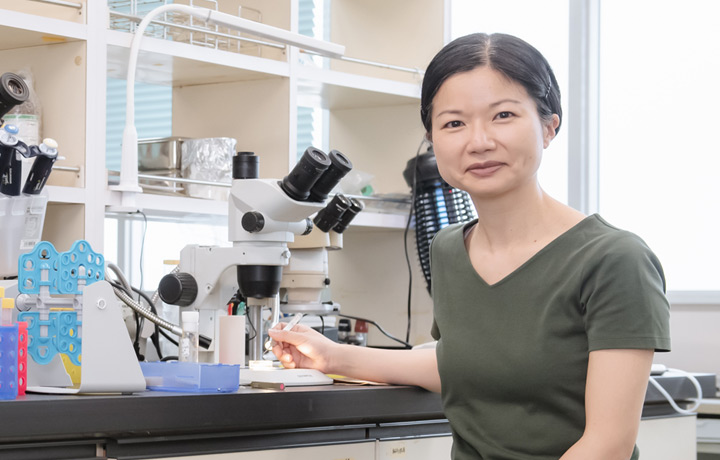Slender and elongated stick insects, along with round ladybugs. What distinguishes these varied forms among different species? Associate Professor Reiko Tajiri of the Graduate School of Science enthusiastically pursues this question, confronting fly larvae every day. The key to solving her inquiry seems to be within the ‘Cuticula.’
Discovered that insect ‘shells’ are more than just ‘Armor’

You are studying the ‘Cuticula’ of insects. What exactly is the cuticula?
In simple terms, it is the shell or skin that covers the surface of an insect’s body. It’s also referred to as the cuticle. Crabs and shrimps, for example, are also encased in a shell, and that shell is essentially a cuticula.
The cuticula serves various functions. It protects and provides structural support to the soft body underneath, and it can emit colors as a signal to other individuals. Among these functions, I am particularly interested in its role in determining an insect’s body shape.
Traditionally, it was assumed that the cells determine an organism’s body shape because they are the building blocks of the body. The cuticula, which is a substance secreted outside the cell, was regarded simply as a coating on the cell’s surface. Consequently, cuticula could be, in many cases, a hindrance when creatures covered with cuticula try to enlarge their entire body or change their shape. This is why insects, shrimps, and crabs have been known to grow by molting−―shedding their old cuticula to accommodate growth.
However, in fruit flies, molting occurs only twice during the rapid growth of their larvae (they can increase their body weight by about 100 times within a few days after hatching). Their bodies continue to expand between molts, and they don’t shed their cuticula when transitioning from elongated larvae to stubby pupae. This intrigued me, so I conducted experiments using Drosophila larvae with various gene mutations.
I then discovered that a change in one of the genes responsible for producing the cuticula led to larvae and pupae taking on different shapes compared to individuals without the mutation. It turns out that the cuticula acts like a corset, actively ‘controlling the body’s shape.’
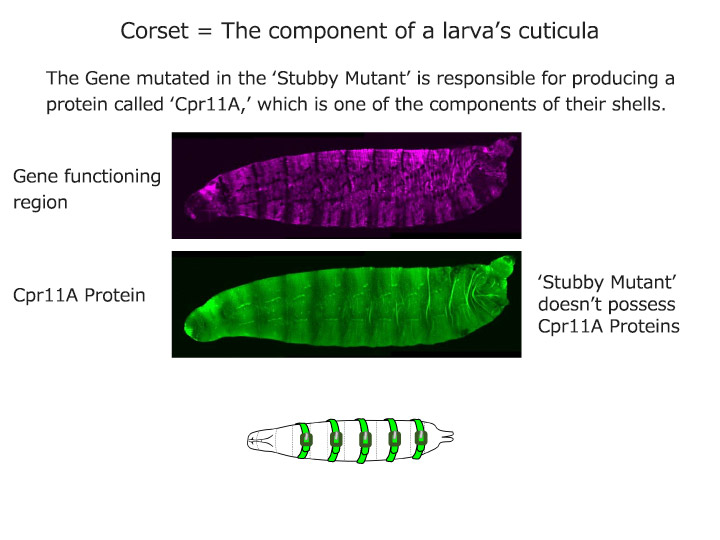
The curiosity about the ‘shape of living creatures’ led me to the study of flies

―It is a discovery that challenges the conventional image of ‘insect shells.’ Did you pursue this research because you have a passion for insects?
My initial inquiry wasn’t limited to insects alone but revolved around the question, “How is the body shape of living organisms determined?” In high school, I joined the biology club and raised frogs and newts. I found it intriguing that these animals, originating from similar round eggs, eventually transformed into frogs or newts.
Moreover, it was fascinating to observe that parents and offspring almost always shared similar appearances. This led me to ponder how genes played a role in shaping the distinctive forms of living beings. As a result, I decided to join a lab studying living organisms’ shapes for my undergraduate studies.
In that lab, I conducted genetic research using Drosophila. As a model organism, Drosophila allowed for easy manipulation, such as removing specific genes or introducing additional genes. This made it straightforward to discover the relationships between genes and physical characteristics.
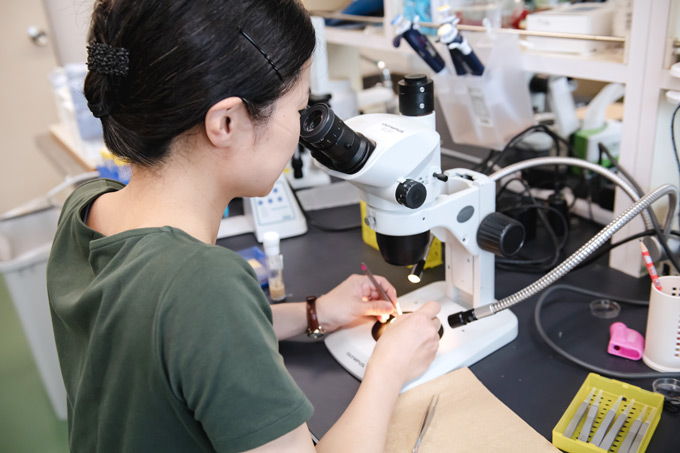
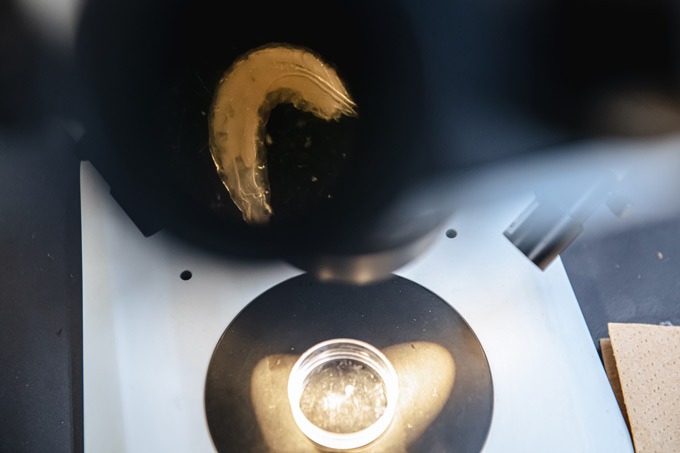
―Your curiosity about ‘Shape’ preceded your passion for insects. Seeing you affectionately examining the fly larvae, I assumed you must be a natural insect enthusiast
Nowadays, Drosophila larvae hold a special place in my heart. I find it adorable to watch well-fed larvae diligently searching for food, moving their tiny mouths.
Applying ideas derived from insect mechanisms and structures to technology

―Does the study of insect cuticula reveal the mechanisms behind determining shapes in living organisms?
Upon completing my graduate studies and becoming a postdoctoral researcher, my supervisor once remarked, “If you delve into something unique to insects, could it potentially lead to research with broader implications in the field of biology?”
Indeed, insects, which rely on external shells for support, and humans, whose internal skeletal systems provide structural support, may seem completely different. However, both insect cuticula and human bones are substances secreted by individual cells to the exterior of those cells, and the secreted substances themselves are not alive. They also share the common trait of being elaborately shaped with various structures.
By studying insect cuticula, I may uncover the mystery of how the structures secreted outside cells to support the body are created in insects and across all forms of life. Alternatively, I believe that I can establish a foundation for addressing this question.
―Your research appears to be quite fundamental. Does it have the potential for direct relevance or practical applications in society?
Surprisingly, it does. It can be applied to ‘Biomimetics*,’ a field that draws inspiration from nature to develop new technologies.
*An approach that mimics the tissues and functions of living organisms and applies them to material development and more.
Insect cuticula serves multiple functions beyond merely being a skeleton and armored structures. For instance, the vibrant metallic sheen of jewel beetles and morpho butterflies is not a result of pigments but rather of intricate ‘structures,’ such as fine protrusions on the cuticle’s surface. Similarly, the water repellency of water striders’ legs is supported by the structure of their cuticula.
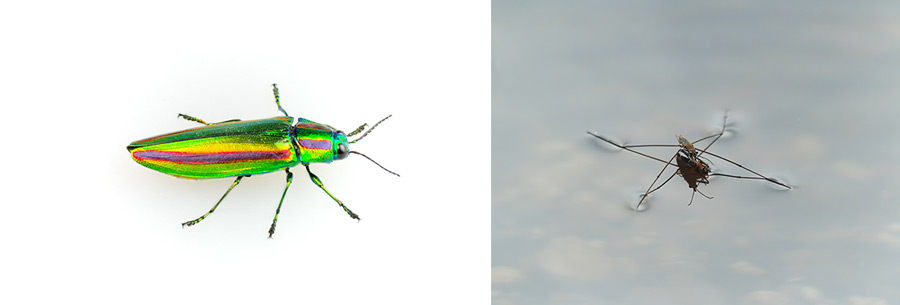
When humans attempt to create materials that exhibit these various functions, they often require significant energy for microfabrication and tend to use harmful or rare substances.
In contrast, insects utilize natural materials such as proteins to create cuticula with complex structures under normal temperature and pressure conditions. The diversity of functions exhibited by this cuticula is likely one of the reasons why insects have prospered on Earth.
Moreover, insects do not construct intricate structures within their cells and then secrete them externally; once they create a substance and release it outside, they leave it as is. While research in this area is still in progress, cuticula seems to possess a molecular structure in which delicate patterns form spontaneously through the binding and repulsion of proteins and sugars.
Humans can create materials with a wide range of functions by imitating those materials and mechanisms. I hope that my work on how insects fabricate those materials will serve as a valuable reference for individuals in the fields of engineering and industry.
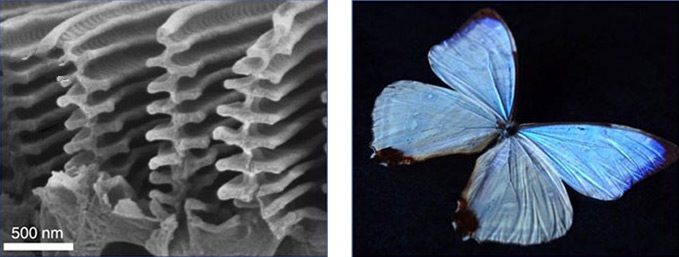
Left: A scanning electron microscope image of the surface of a morpho butterfly’s wing scales.
Right: A photograph of a morpho butterfly.
The layered structure of the cuticula on these scales shows beautiful colors by strongly reflecting specific wavelengths of light through light interference. It is believed that these colors are utilized for communication among living organisms.
I want to approach the “evolution” of the body shape of insects
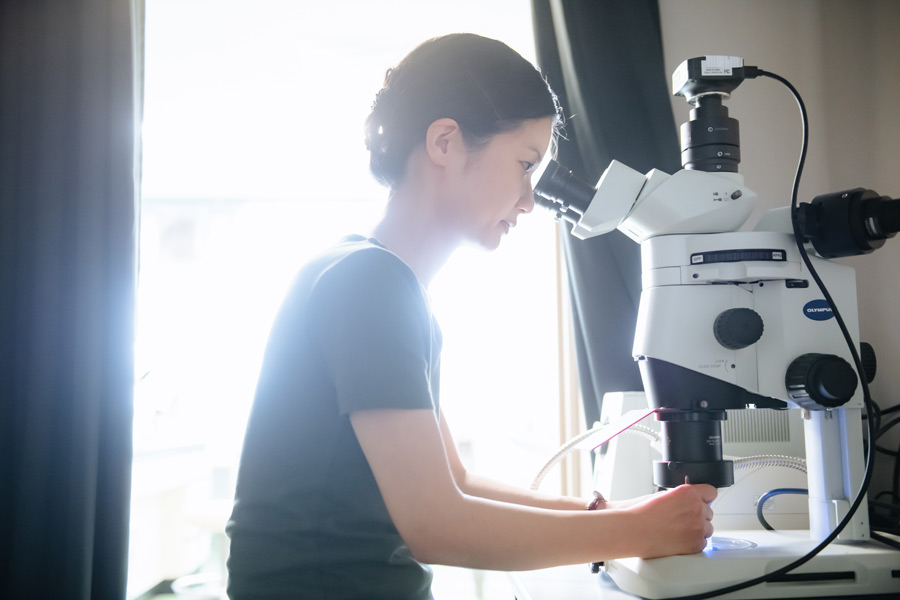
―How do you plan to advance your research in the future?
While I will continue working on Drosophila, I also intend to explore the relationship between the body shape and appearance of various insects and their cuticula and genes. I plan to achieve this by introducing cuticula genes from different inset species into Drosophila. Currently, I am taking on the challenge of studying the green bottle fly, which exhibits a metallic luster.
In addition, I believe that by observing the ‘present’ state of each body shape, I can trace their ‘evolutionary’ history. For instance, how did the stick insect evolve into its elongated form, and how did the ladybug adopt its round shape? The interplay between the cuticula that determines body shape and genetic factors offers many insights, and the excitement of this research lies in the continuous emergence of new ‘unknowns.’
―Please give a message to high school and university students who are uncertain about their choice of university and research lab.
When I entered university, I had a vague idea of majoring in physics and mathematics. However, as I explored various fields at university, I realized that “What had previously piqued my interest is something well worth addressing as a research topic.” This revelation set me on the path I’m on today.
When choosing your career path, you may be concerned about its potential advantages for future employment. However, it’s important to understand that your research as a student may not necessarily translate directly into your future workplace. What truly enriches us is the ‘experience’ of formulating hypotheses, designing experiments to address the hypotheses, and engaging in trial and error. Research often encounters hurdles and setbacks, so it’s a good idea to meticulously explore subjects you genuinely enjoy and care about to maintain your motivation and dedication.
If you are fascinated by the diversity of life forms, intrigued by the relationship between shapes and genes, or eager to uncover the secrets of insect vitality, feel free to pay a visit to our laboratory.
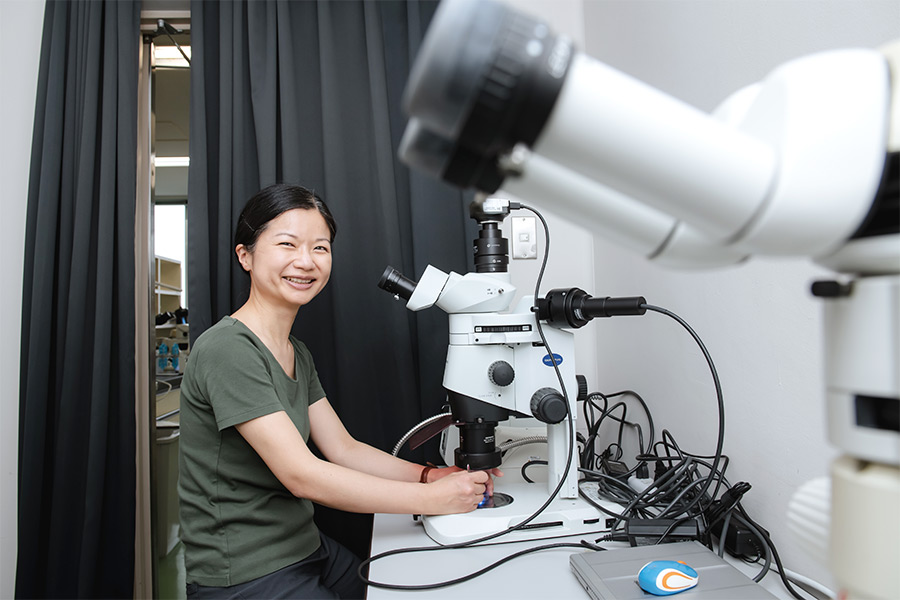
Recommend
-

From ELSI to RRI: Exploring the Ethical Landscape of Science and Technology
2024.11.21
-
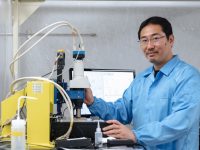
The Quest for High-Energy Neutrinos: Chasing a Complete Theory of the Universe
2024.12.19
-

On the Road to Establishing a Performing Arts Medicine Center: Specialized Doctors for Musicians and Ballet Dancers
2023.06.02


